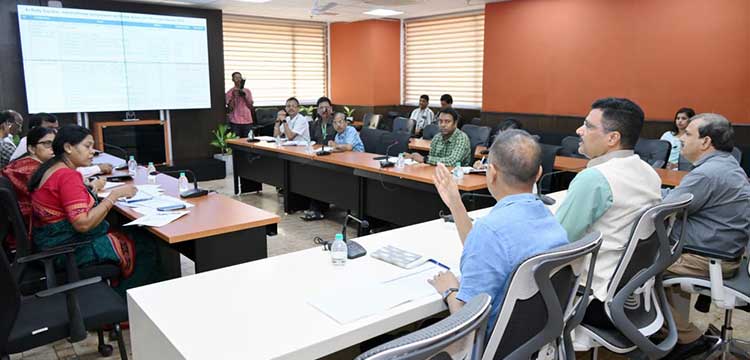Bhubaneswar: With the India Meteorological Department (IMD) predicting scattered to moderate rainfall across Odisha over the next few days, the Agriculture and Farmers’ Empowerment Department has urged farmers to stay alert and take precautionary measures to protect their crops.
A preparatory meeting on the impending rainfall was held today under the chairmanship of Dr. Arabinda Kumar Padhee, Principal Secretary, Agriculture Department. The meeting was attended by Shubham Saxena, Director of Agriculture, Manorama Mohapatra, Director, IMD Bhubaneswar, and Prof. Prasannajit Mishra, Dean, OUAT, among other senior officials.
According to the IMD, while no cyclone formation has been confirmed yet, a low-pressure system over the southwest Bay of Bengal is likely to intensify into a depression, bringing rainfall to several districts of Odisha between October 24 and 26. The southern, coastal, and parts of northern districts are expected to experience light to moderate rain accompanied by thunderstorms and lightning.
Dr. Padhee advised farmers to remain calm and follow the official advisories issued by the IMD and the Agriculture Department. He emphasized that Odisha has received 100 percent of normal rainfall this year, which is expected to result in a favorable crop yield.
The department also cautioned farmers against misinformation and advised them to seek guidance through the toll-free helpline 155333 or by contacting the nearest Regional Agricultural Research Center or Agriculture Officer.
Advisory for Farmers to Prepare for Potential Rainfall
According to the forecast by the Bhubaneswar Centre of the India Meteorological Department, a low-pressure system formed over the southwest Bay of Bengal is likely to intensify into a depression. This may lead to light to moderate rainfall across various districts of Odisha for the next five days. The impact is expected to be significant in south and coastal Odisha, as well as parts of north Odisha, with rainfall likely to increase from the 24th to the 26th. Farmers are advised to stay vigilant and take the following measures to mitigate potential damage:
Pre-Rainfall Preparations:
Paddy Harvesting: If short-duration and medium-duration paddy crops have reached 85% maturity, harvest them immediately and store them in a safe, dry place.
Paddy Protection: For harvested short-duration paddy, thresh it or cover it with polythene and store it in a safe, elevated location.
Maize Harvesting: If maize crops are ready for harvest, collect them as soon as possible.
Kharif Pulses and Groundnut: Harvest matured kharif groundnut, green gram, and black gram and store them in a safe place.
Sugarcane: Tie sugarcane stalks to provide support against strong winds or rain.
Drainage for Paddy Fields: Create drainage channels in paddy fields to ensure excess water flows out, and keep the channels clear.
Vegetable Nursery: Arrange for proper drainage to remove excess water from vegetable nurseries.
Vegetable Harvesting: Harvest crops like cauliflower and cabbage if they are ready.
Rabi Crop Sowing: Suspend sowing of Rabi crops until the rainfall subsides.
Post-Rain Vegetable Care: After the rain, support fallen vegetable plants by adding soil around their roots to help them stand upright.
Replanting Damaged Vegetables: If vegetable crops are completely damaged, prepare the land after the weather stabilizes and replant short-duration cabbage or other winter vegetable crops.
Fruit Orchards: Ensure proper drainage in fruit orchards to prevent waterlogging.
Coastal Areas: In coastal regions, provide support to banana and papaya plants by propping them up.
Flower Crops: Flowers like marigold and rose may get damaged due to rain. Harvest them promptly to avoid losses.
Post-Rainfall Pest and Disease Management:
After the rainfall, crops like paddy, vegetables, and pulses may be susceptible to pests and diseases. Adopt the following management practices:
- Paddy Crops: a) Root Weevil:
Ensure proper drainage of water from fields.
Create ridges at 6-foot intervals.
Apply Pymetrozine 50% WG (120 g/acre), Dinotefuran 20% SG (80 g/acre), or Flonicamid 50% WG (60 g/acre) mixed with 200 liters of water and drench the root zone.
b) Stem Borer:
Stem borer attacks may increase after rain and sunny weather. To control, apply Chlorpyrifos 50% + Cypermethrin 5% EC (400 ml/acre) or Profenofos 50% EC (400 ml/acre) mixed with 200 liters of water in the afternoon.
c) Stink Bug:
Low temperatures after rain may lead to stink bug infestations. Apply Chlorpyrifos 1.5% dust (10 kg/acre) or Malathion 50% EC (400 ml/acre) mixed with 200 liters of water and spray in the morning.
d) Panicle Mite:
Panicle mites may affect paddy during the grain-setting stage, causing grains to turn black or grayish. To control, apply Fenazaquin 10% EC (400 ml/acre), Fenpyroximate 5% EC (400 ml/acre), Propargite 57% EC (400 ml/acre), or Difenoconazole 50% WP (400 g/acre) mixed with 200 liters of water, spraying once a week for two weeks.
e) Neck Blast / Panicle Blast:
After rain, paddy may be affected by neck or panicle blast. Apply Tricyclazole 75% WP (120 g/acre), Kasugamycin 3% SL (400 ml/acre), or Kresoxim-Methyl 48% EC (400 ml/acre) mixed with 200 liters of water and spray.
f) Sheath Blight:
Sheath blight may cause the base of paddy plants to rot, preventing panicle emergence. Apply Carbendazim 50% WP (300 g/acre), Carbendazim 12% + Mancozeb 63% WP (400 g/acre), or Tebuconazole 25% EC (200 ml/acre) mixed with 200 liters of water and spray.
g) Bacterial Leaf Blight (BLB):
For bacterial leaf blight, apply Copper Oxychloride (600 g/acre) + Streptomycin (20 g/acre) mixed with 200 liters of water and spray.
- Vegetables and Pulses: a) Aphids:
Aphids may affect vegetables and pulses. Apply Imidacloprid 17.8% SL (60 g/acre), Thiamethoxam (40 g/acre), or Acetamiprid 20% SP (50 g/acre) mixed with 200 liters of water and spray.
b) Powdery Mildew:
Powdery mildew may affect green gram, black gram, and other pulses after rain. Apply Sulfur 80% WG (500 g/acre) or Carbendazim 50% WP (200 g/acre) mixed with 200 liters of water and spray.
c) Downy Mildew:
Downy mildew may affect vegetable crops after rain. Mix Streptomycin (1.5 g) and Copper Oxychloride (25 g) in 10 liters of water and drench the root zone.
Note: For further information or assistance, contact your nearest Krishi Vigyan Kendra (KVK), Regional Agricultural Research Station, Agriculture Officer, or the toll-free number 155333.
This advisory aims to help farmers minimize losses and protect their crops during the expected rainfall period.



















